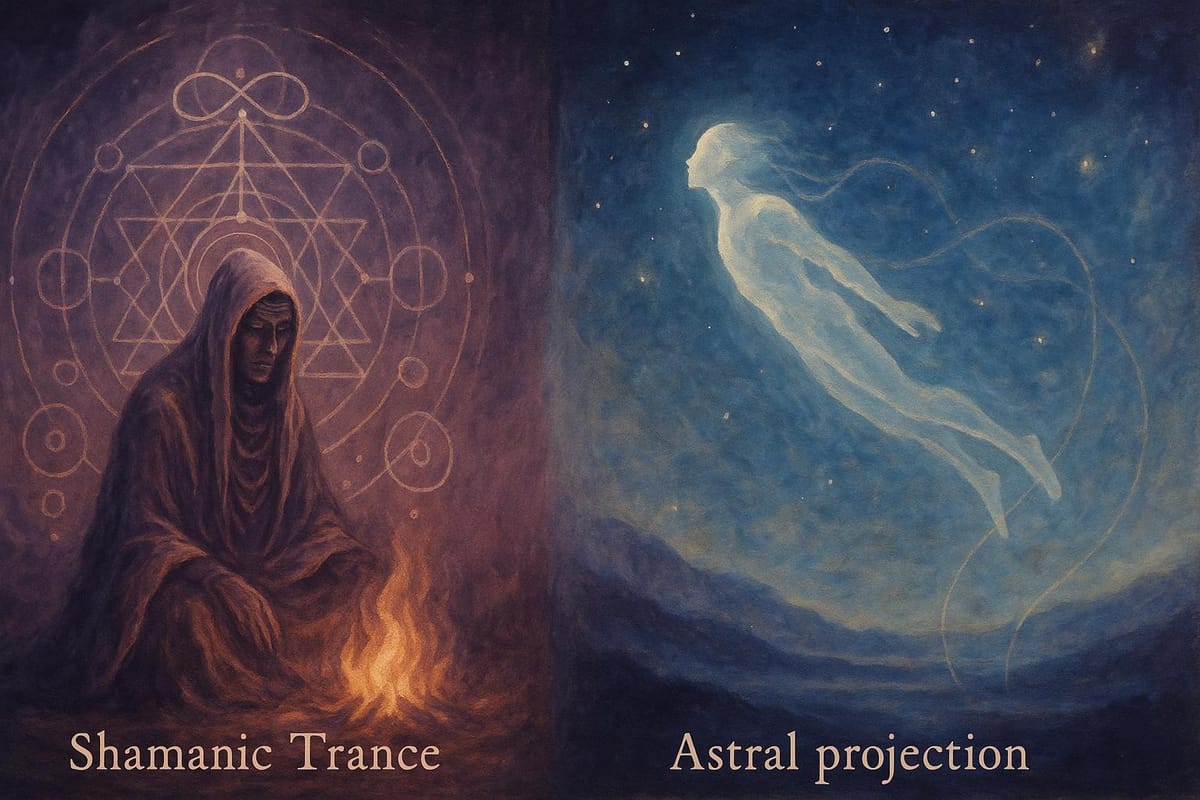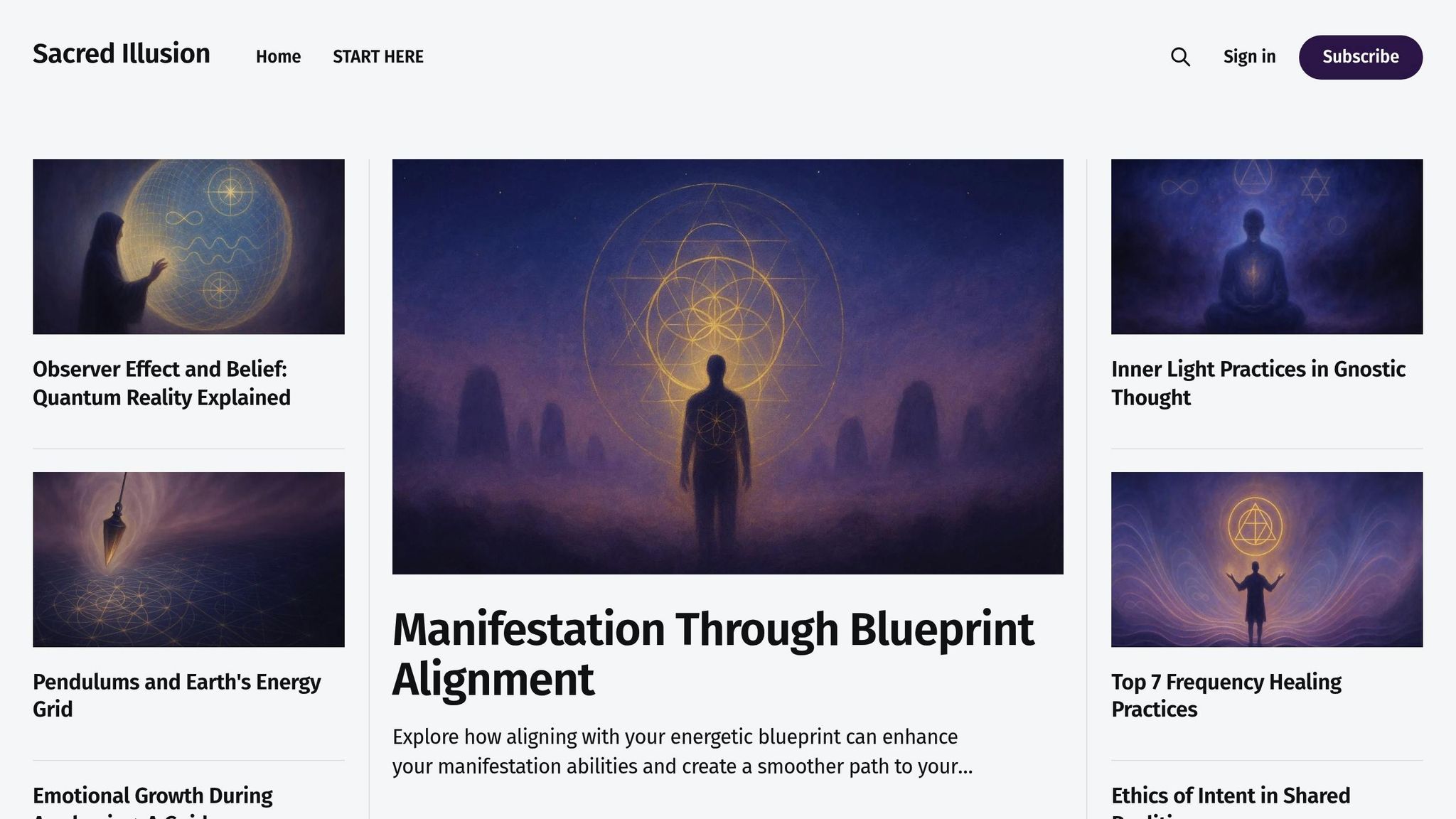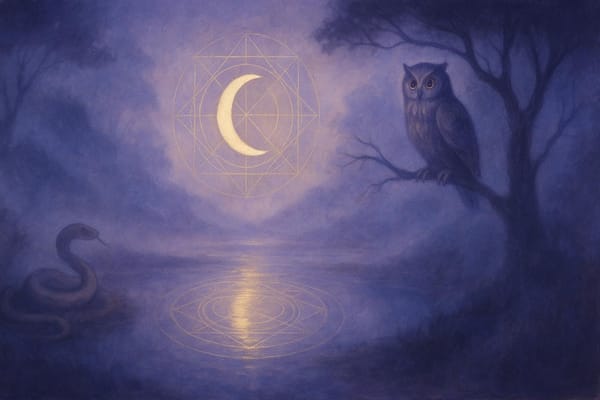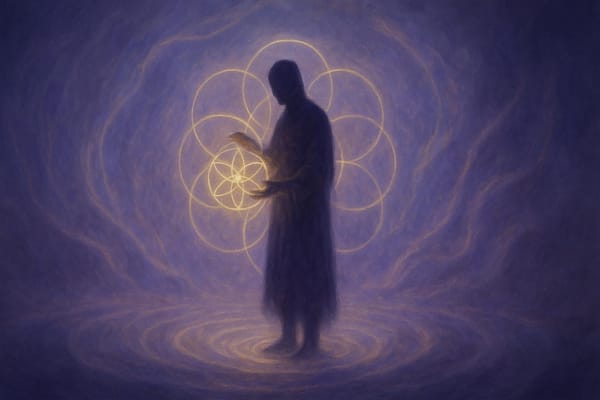Shamanic Trance vs. Astral Projection
Explore the distinct paths of shamanic trance and astral projection, revealing their unique methods, purposes, and transformative potential.

Shamanic trance and astral projection both explore altered states of consciousness, but they serve different paths.
- Shamanic trance: Rooted in communal rituals, it connects the physical and spiritual worlds through drumming, chanting, or natural substances. It often serves collective healing and guidance.
- Astral projection: Focuses on individual exploration, where consciousness separates from the body to access non-physical dimensions. Techniques include relaxation, visualization, and energy work.
Key Difference: Shamanic trance emphasizes shared healing within a guided framework, while astral projection is a solitary journey into self-awareness.
Quick Comparison
| Aspect | Shamanic Trance | Astral Projection |
|---|---|---|
| Induction Methods | Drumming, chanting, plant substances | Relaxation, visualization, energy work |
| Focus | Community healing, spiritual guidance | Personal growth, self-exploration |
| State of Being | Embodied awareness | Out-of-body experience |
| Guidance | Rituals led by experienced practitioners | Self-directed |
Both practices invite you to question reality’s layers, offering tools to navigate your soul map. Which path resonates with your journey?
Shamanic Trance: Origins, Methods, and Purpose
History and Cultural Background
Shamanic trance practices have their roots in cultures around the world. Ancient societies often sought altered states of consciousness as a bridge to the spiritual realm, with practitioners acting as intermediaries between the physical world and the unseen. This recurring role of connection and guidance has shaped a wide array of traditions, each with its own methods of entering these profound states.
Main Methods
In addition to rhythmic drumming and chanting, various cultures have developed unique ways to shift consciousness. Breathwork, ritualistic dances, fasting, and other ceremonial practices are common approaches. Some traditions also incorporate sacred plants or natural substances to deepen the trance experience. While the tools and techniques differ, the shared goal is to create a space for spiritual insight and transformation.
Goals and Applications
The purpose of these practices extends beyond the individual, addressing both personal and collective needs. Trance states are often used to promote healing, seek guidance, and restore balance. Underpinning these practices is the belief that personal harmony is deeply connected to the well-being of the community and the natural world.
Astral Projection: Definition, Methods, and Goals
What Is Astral Projection
Astral projection refers to an experience where consciousness seems to step beyond the boundaries of the physical body. Many describe it as a journey into realms that exist outside ordinary perception, offering a chance to explore layers of awareness that feel both personal and expansive.
How to Induce Astral Projection
To experience astral projection, certain practices can help guide you into this state. Techniques often begin with deep relaxation to quiet the body and mind, creating a foundation for the process. Visualization plays a key role, as it helps to mentally separate from the physical form. Meanwhile, energy-focused exercises can further support the transition, amplifying the sense of detachment and clarity.
Common Purposes
People often turn to astral projection as a way to deepen their understanding of consciousness or to engage in meaningful self-reflection. The reasons for exploring this practice vary widely, shaped by individual goals and the desire to uncover deeper truths about the self and the nature of reality.
Shaman's Dream | Deep Shamanic Trance | Healing Meditation Music [Lucid Dream & Astral Projection]
Shamanic Trance vs Astral Projection: Key Differences
Exploring the methods and purposes of these practices reveals their unique distinctions. Both involve altered states of consciousness, but they diverge significantly in technique and philosophy. Shamanic trance is deeply rooted in ceremonial traditions, often guided by seasoned practitioners. These rituals use sensory cues like drumming, chanting, or plant medicines to bridge the physical and spiritual realms, often within a communal setting.
Astral projection, on the other hand, is a more solitary endeavor. It focuses on deep relaxation, visualization, and energy work, with practitioners honing their ability to detach their consciousness from the physical body without external tools or aids.
Side-by-Side Comparison
| Aspect | Shamanic Trance | Astral Projection |
|---|---|---|
| Induction Methods | Drumming, chanting, dance, plant medicines | Deep relaxation, visualization, energy work |
| State of Consciousness | Altered but embodied awareness | Out-of-body experience |
| Realms Accessed | Spirit world, shamanic cosmology | Astral plane, non-physical dimensions |
| Guidance Structure | Ritual-based, often with teachers or elders | Self-directed, individual practice |
| Cultural Context | Indigenous traditions, community healing | Modern spiritual exploration |
| Primary Goals | Healing, divination, soul retrieval | Consciousness exploration, spiritual growth |
These differences highlight the varied ways in which individuals navigate the layers of consciousness, a theme central to Sacred Illusion.
What They Share
Despite their differences, both practices share some foundational elements. Both require clear intentions and preparation. Whether it's through the ritualistic practices of shamanism or the disciplined relaxation techniques of astral projection, practitioners must approach these states with focus and care.
Protection is another shared priority. Shamanic practitioners often rely on traditional safeguards, such as power animals or spirit guides, while those engaging in astral projection use visualization techniques to create energetic boundaries. Both approaches emphasize respect for the process and the realms being accessed.
The transformative potential of these experiences is profound. Many who engage in either practice report shifts in their understanding of reality, personal healing, and spiritual growth. These insights often ripple into their everyday lives, leaving lasting impressions.
Main Differences
The most striking difference lies in their cultural roots and communal involvement. Shamanic trance is deeply embedded in indigenous traditions, serving not only the individual but also the larger community. Shamans act as intermediaries, channeling healing and guidance for the collective.
Astral projection, however, has emerged primarily from modern Western spiritual practices. It focuses on personal exploration and individual growth, with practitioners often working alone to interpret their experiences in non-physical realms.
Another key distinction is the relationship to the physical body. In shamanic trance, the practitioner remains physically present, often responding to real-time guidance from facilitators. Astral projection, by contrast, centers on the intentional separation of consciousness from the body, creating a sensation of floating or moving apart from the physical self.
The learning paths also differ. Shamanic practitioners typically undergo extensive apprenticeships under experienced mentors within established traditions. Those exploring astral projection often take a self-guided approach, drawing on books, online resources, or personal experimentation to develop their practice.
Benefits and Risks of Each Practice
Exploring shamanic trance and astral projection can be an intriguing part of a personal or spiritual journey. While these practices hold the potential for meaningful experiences, it's essential to approach them with awareness and care. Their benefits are often anecdotal, and the challenges they present should not be overlooked.
Possible Benefits
Shamanic trance, particularly in ceremonial settings, can open pathways to personal insights while fostering a sense of shared connection within a group. The experience often feels deeply rooted in community and tradition, creating a supportive environment for self-discovery.
Astral projection, on the other hand, can offer a fresh lens through which individuals may examine their perception of reality. For some, it sparks profound moments of reflection, leading to a deeper understanding of their place within the broader tapestry of existence.
Potential Risks
Engaging with altered states of consciousness can sometimes make reintegration into daily life a complex task. While concrete evidence on risks remains limited, it’s wise to approach these practices with patience and mindfulness. Emotional and mental well-being should always take priority.
Building a strong foundation of support - whether through personal reflection, trusted companions, or expert guidance - can help navigate the challenges that may arise. Thoughtful preparation and a gradual approach can ensure these explorations remain meaningful and safe.
Ethics and Respect
Beyond personal experiences, the ethical dimension of these practices deserves attention. Shamanic trance, in particular, is deeply tied to cultural traditions. Honoring its origins means seeking guidance from those with genuine knowledge and respect for its roots.
For both practices, maintaining a sense of personal responsibility, clear intention, and humility is essential. These principles not only safeguard the individual but also promote a respectful integration of these experiences into one’s life.
Modern Applications and Integration
In today's world, practitioners are weaving ancestral knowledge with contemporary insights, crafting new pathways for exploring consciousness. The once-distinct practices of shamanic trance and astral projection are now blending, creating a more fluid and adaptable approach to spiritual exploration.
Combining Both Practices
Building on traditional foundations, modern seekers are merging shamanic and astral techniques to deepen their experiences. Often, they begin with shamanic methods like rhythmic drumming or breathwork to enter an altered state, then transition into the deliberate techniques of astral projection. This fusion allows for a richer exploration of consciousness, balancing the grounded nature of shamanic work with the boundless expanses of astral travel.
Visualization, meditation, and controlled breathing are key tools in these practices, helping to stabilize and deepen the journey. Setting clear intentions is essential - whether the goal is healing and guidance through shamanic methods or exploring the vastness of consciousness through projection. By focusing on an inner light during these states, practitioners can enhance both the vividness of shamanic visions and the clarity of astral experiences, bridging the earth-centered roots of shamanism with the expansive reach of astral techniques.
Harmonic resonance - achieved through drumming, chanting, or visualization - serves as a unifying thread between these practices, aligning personal energy to support deeper states of awareness.
Connection to Sacred Illusion Themes

These evolving practices expand upon the ancient traditions discussed earlier, offering new ways to interpret sacred experiences. Through the lens of reality as a system or illusion, they invite questions about the true nature of existence: is it a shared consensus, a simulation, or something entirely different?
Sacred sites, for instance, might act as energetic portals within this simulated framework. Focused spiritual work at such locations could uncover insights into the structure of reality itself. This perspective aligns with the idea of reality as code, where intentional practices at these sites might reveal hidden layers of the system.
By exploring the interplay between quantum reality and emotion, practitioners tap into a scientific-metaphysical framework that highlights the fluid nature of consciousness. Through trance states or astral projection, they may engage with this malleability, raising profound questions about whether we inhabit a physical universe, a consciousness-driven system, or a construct resembling advanced code.
Modern rituals combine traditional elements with contemporary understanding, creating spaces for transformation and self-discovery. These ceremonies, rooted in intention and inner wisdom, become experiments in understanding the nature of reality. By blending shamanic and astral techniques, practitioners push the boundaries between self and the larger system, uncovering new layers of connection and meaning.
From indigenous wisdom to personal mastery, modern mystery schools now offer structured ways to explore these integrated practices. They echo the themes of Sacred Illusion, delving into the duality of reality as both a construct and an enigma, inviting seekers to journey deeper into the mysteries of existence.
Conclusion: Which Practice Is Right for You
Choosing between shamanic trance and astral projection depends on your personal goals and how you prefer to explore consciousness. Each offers a unique path to deeper awareness.
Shamanic trance is rooted in structured rituals, often guiding you through introspection and fostering personal growth. If you value a more traditional and guided approach to inner work, this method might resonate with you.
On the other hand, astral projection leans into open-ended self-exploration, making it a better fit for those who enjoy charting their own course and embracing a freer, less structured experience.
Modern practices often blend elements of tradition with individual preferences. Your choice will ultimately reflect your background, learning style, and intentions. Both paths expand awareness in their own way - trust the one that feels aligned with your journey and stay open to the unfolding of your spiritual experiences.
FAQs
How can I decide between exploring shamanic trance or astral projection for my spiritual growth?
Choosing between shamanic trance and astral projection often comes down to your personal intentions and the path that resonates most with your spirit.
Shamanic trance invites you into altered states of consciousness through rituals or guided practices, often with the purpose of connecting to spirit guides or uncovering deeper layers of wisdom. It’s a practice rooted in ritual and often feels grounded, offering a sacred space to journey inward.
Astral projection, by contrast, is about consciously stepping beyond your physical form to explore non-physical realms or dimensions. This approach might resonate with those drawn to out-of-body experiences or the desire to directly engage with the metaphysical layers of existence.
Consider what aligns with your current spiritual focus: a ritual-driven inward journey or a boundless outward exploration. Both paths hold their own revelations and can beautifully complement one another as you navigate the sacred map of your soul.
What risks or challenges might arise during shamanic trance or astral projection, and how can they be managed?
Engaging in practices like shamanic trance or astral projection can occasionally bring up challenges - encounters with unsettling entities, moments of disorientation, or difficulty distinguishing between altered states and everyday life. While these experiences might feel intense, they are not unusual and can be approached with care and preparation.
To navigate these moments, begin by establishing a stable and secure space for your journey. Take time to set clear intentions, ensuring your purpose is well-defined. Incorporate grounding techniques to stay anchored, and create an environment that feels both safe and supportive. Cultivating a strong sense of discernment is equally important, as it allows you to interpret your experiences with clarity and approach them with confidence.
Can shamanic trance and astral projection be combined into one practice? If so, how can this be done effectively?
Yes, blending shamanic trance with astral projection can be done, but it calls for a mindful and intentional approach. While both involve entering altered states of consciousness, their aims differ - shamanic trance typically seeks connection with spiritual realms for healing or guidance, whereas astral projection is about consciously navigating non-physical dimensions.
To bring these practices together, begin by setting a clear purpose for your journey. Rhythmic drumming or deep meditation can help you enter a trance state, while visualization and focused energy work can steer you toward astral exploration. Staying grounded and centered is crucial, as these experiences can be quite powerful. With patience and consistent practice, you might discover a way to explore both realms in harmony.




